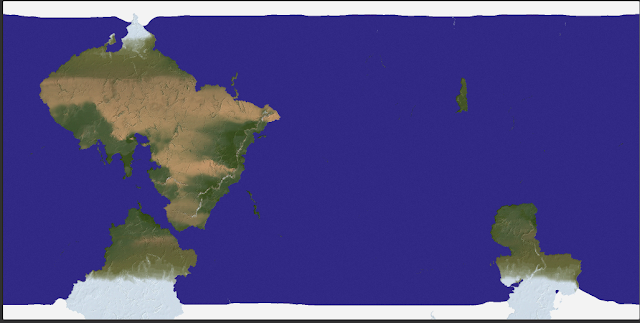The resizing of the world map showed up a lot of problems with the climate simulation. In particular, I found that on a larger scale, the methods I was using to track precipitation - of following lines of precipitation from the coasts inland - didn't work. They resulted in a stringy appearance. I also found that some of the climate classification calculations were incorrect, and basically all sorts of stuff was wrong. So I've taken the opportunity to do a fairly substantial overhaul of the whole system.
As always, remember that climate simulation is staggeringly complex and difficult, and my model can only hope, at best, to produce something vaguely believable. Still, I think it's an improvement. This is what I've done:
- Rewritten the prevailing wind precipitation, so that UW tracks all of it in a single sweep rather than line-by-line. This allows the rainfall to bloom out as it moves across the land, avoiding the sometimes annoyingly straight lines between areas of high and low precipitation that we had before. It can do this across areas with no prevailing wind, too, though it loses strength as it does so.
- Done the same thing with the monsoon precipitation. Instead of the "blobs" approach that I used before, we now have monsoons sweeping inland in great swathes. These now create proper savannahs as well.
- Changed all precipitation to be calculated at a finer grain, ensuring that it doesn't blur across mountain ranges as it used to.
- Made the bands of winds much wobblier, to create more variation in the latitudes at which deserts tend to appear.
- Added more precipitation in general, particular at temperate/subtropical latitudes.
- Reduced the amount of precipitation that falls on mountains (though not reduced the strength of rain shadows to match), ensuring that rainforest no longer appears quite so often on high ground in the middle of deserts.
- Made temperatures more extreme as you get further from the sea.
- Rewritten the functions that force Mediterranean climates so that they appear more naturally.
- Added functions to force subpolar climates in roughly the appropriate latitudes.
- Fine-tuned the temperature calculations by latitude to ensure that climates appear at the appropriate points.
- Reworked the climate classifications to be more accurate, and ensured that the colour scheme matches the standard one.
- Reworked the depiction of temperature and rainfall on the relief map to reflect the different climates a little more realistically.
- Added a new colour for cold deserts on the relief map.
Most of this involved throwing in lots of magic numbers and twiddling them until things looked less bad. And most of that involved trying to get things back to how they were when I started. Still, I think the result is better than what I had before. There are still issues - my climates don't form such large, neat areas as they do in the real world; there's an annoying tendency for warm-summer humid continental areas to alternate with subpolar ones, which I can't get rid of without messing up everything else; there's too much tundra; the transition between rainforest and savannah is often too abrupt; but overall it's broadly doable. Oh and of course it's all much slower now, but it's worth it to get a more plausible final result.
So here are some global maps, in both their relief and climate versions. Climates are classified according to the Köppen-Geiger climate classification, and shown using the same colours (based on Peel, Finlayson, and Mcmahon 2007).
Now of course doing all that has messed up how precipitation is calculated at the regional level, so I need to rework that too! Yay!







This is looking awesome.
ReplyDeleteI'm thinking I need to introduce some variation in my winds as well: your climate bands are nicely warped.
I had the same issue with rainforest/savannah which makes me think there is a problem with the way the Koppen climates are defined. That makes sense because Koppen describes the Earth, it doesn't prescribe anything specifically.
That may well be so! Of course, the climate classifications don't really matter in themselves. They're wholly dependent on the rainfall and temperature, so they're really just a useful tool to check that the rainfall and temperature are roughly right. You'd need a supercomputer and a dedicated research team to do the job properly, so I'm content if it looks roughly plausible.
ReplyDelete